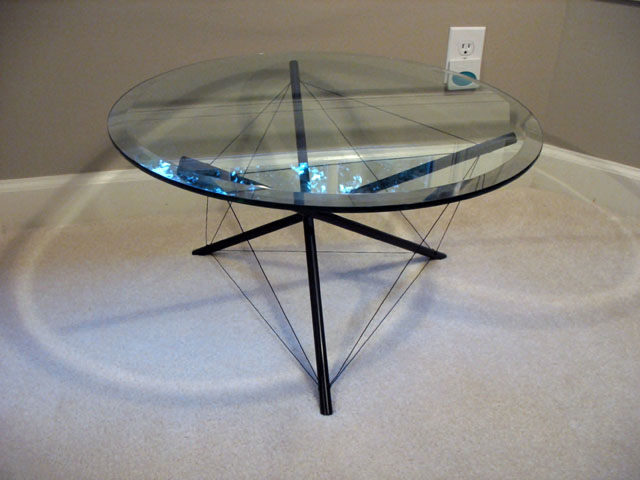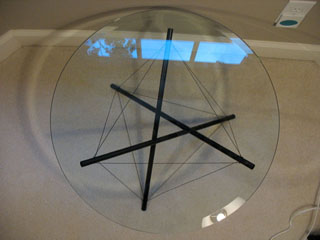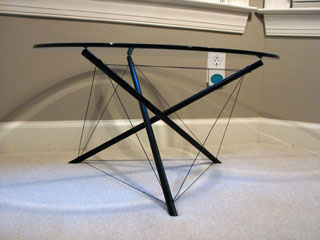
In need of a new coffee table for my dorm room and itching to build something,
William Guilford came to the rescue. He's got a great how-to
(if the link doesn't work, try here.)
on building a tensegrity coffee table that's both chic and seemingly impossible.
Tensegrity structures,
first investigated by Kenneth
Snelson, are formed from only wires and rods, constructed in such
a way that none of the rods touch each other. This seems to defy physics
at first glance, but actually the tension in all the wires work in unison
to hold each of the rods in place, forming a suprisingly rigid structure.
The word "tensegrity" comes from tension and integrity, both of which
the structures exhibit. Usually, tensegrity units are stacked on top of
each other to form towers. In this situation though, only one unit is
used, and a circular piece of glass is placed on top.
I'm not going to go into great detail about making the actual table--Dr.
Guilford did that
already. However, I'll go over the basics. Your supplies are as follows:
- 3 pieces of 1/2" copper
tubing, each 2' long
- About 25' of picture hanging
wire (#4 is suggested, just make sure it's fairly thick)
- 1/8" rivets
- Glass tabletop (I used 24"
diameter x 1/4" thickness)
- ~5/8" rubber stoppers
|
First, you drill four evenly-spaced 1/8" holes on either side of
the copper tubes. Then, you "weave" them so each tube goes both under
and over another(somewhat visible in the pictures to right). The top
and bottom of this structure are wired together in a triangular shape
using rivets. Then the tops of the tubes are wired to the bottoms
of the adjacent tubes, forming a semi-rigid structure. To make the
structure completely solid, you have to connect the tops and bottoms
again, but this time using the left over holes. Essentialy, many triangles
of taught wire will be formed, holding the whole shebang together.
Finally, I painted the table flat black with some spraypaint. The
rubber stoppers are used to hold the tabletop in place and protect
the glass from the rough edges of the tubing. Rubber stoppers were
the best I could come up with, but if they can be found, 1/2" rubber
caps would work much better.
So, in the end, I got a really great looking table that was fun
to build. How sturdy is it? Well, I use it to hold some plants and
magazines. Occasionally I use it as a laptop table as well. When
I first made it, I didn't secure the last set of 3 wires enough,
so they eventually slipped out. The table didn't fall, because those
3 wires simply make it rigid and don't actually support the glass.
Nevertheless, I found it is those last 3 wires that seem to lose
their tension over time. So, be sure to secure those really well,
even if you have to jam that rivet into the hole. Overall, I'm pleased
with the table, after I fixed the wire-slippage problem. Keep in
mind the dimensions can easily be changed to suit your needs.
|
 |
 |


